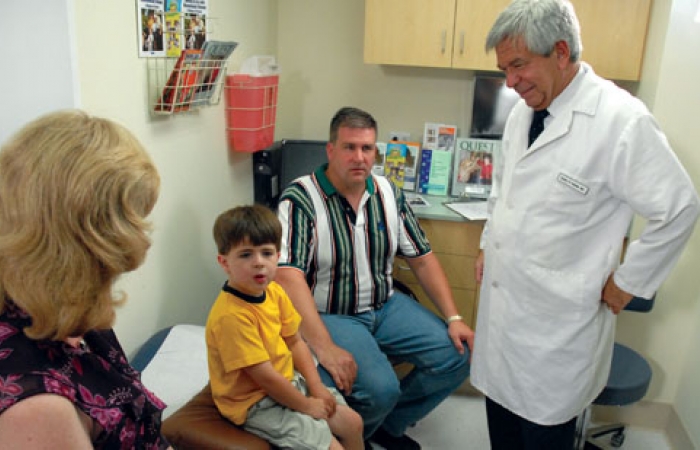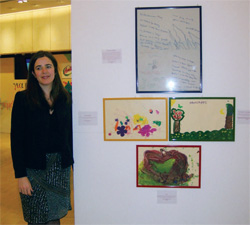
The International Heartsongs Project

'Palliative care' means more than 'end-of-life' care for children and families coping with muscle disease
Families face complicated health care decisions when coping with a child’s neuromuscular disease, and the best course of action isn’t always clear. Often, the child’s doctors are in uncharted territory too.
Now, MDA is trying to provide a road map through this confusing, emotional time by offering families and physicians enhanced “palliative care” services for the children it serves.
Although the term “palliative care” traditionally is associated with hospice or end-of-life care, it takes on new meaning when applied to children with muscle diseases, says MDA Vice President of Advocacy Annie Kennedy.
For these children, Kennedy says, “palliative care begins when a child receives a diagnosis, and continues throughout that child’s life, regardless of any treatment received.”
Pediatric palliative care seeks to address not only the child’s comfort and quality of life, but also medical communication, decision making, access to resources, and the family’s emotional needs.
Says Kennedy, “One of the greatest services MDA can provide is to connect the families we serve to valuable resources. We want to expand and extend the palliative care services available to our families — focusing on ‘quality of life,’ not ‘end of life.’”
An international effort
While some fields, such as oncology (cancer care), do provide pediatric palliative care, it’s a new idea in the care of children with muscle diseases.
But that’s changing, not only in the U.S., but around the world.
MDA’s palliative care program is part of the International Heartsongs Project, a collaboration among seven countries to improve services for children and families affected by pediatric neuromuscular diseases, particularly Duchenne muscular dystrophy (DMD) and type 1 spinal muscular atrophy (SMA1). The project was named in honor of former MDA National Goodwill Ambassador Mattie Stepanek.
Heartsongs was conceived as an international project, funded by the Stavros Niarchos Foundation and co-directed by Gail Geller and Cynda Rushton from the Johns Hopkins Berman Institute of Bioethics.
The participating countries — Australia, Canada, Denmark, France, Greece, United Kingdom and the United States — all have active muscular dystrophy organizations with a readiness to integrate palliative care into their programs, says Geller.
The aim of the international project, she explains, is “to marry two worlds — the muscular dystrophy community and pediatric palliative care programs — by bringing together the active partnership and voices of interdisciplinary professionals, palliative care professionals, parents and children.”
Redefining palliative care
A palliative care program for children with muscular dystrophy, “says nothing about when, or even whether, the child will die,” Geller says.
“It simply says that since there’s a possibility the child might have a life-threatening or life-limiting experience, they can benefit from these services at any time, and these services ought to be woven into their overall care early on before it becomes a crisis issue.”
Palliative care services include:
- managing pain and other symptoms;
- addressing quality-of-life issues, such as mobility, environment and rehabilitation;
- addressing the emotional and spiritual needs of families;
- educating adolescents about their disease, prognosis and treatment; and
- adding palliative care professionals to a child’s health care team.
People receive better care within such a model, says Petra Kaufmann, co-director of the MDA Clinic at Columbia University, N.Y., “not because of changed medications or standards, but because their care is better coordinated and better able to accommodate the needs of the entire family.”
The goals of a palliative care program run parallel with the goals of seeking treatments and cures for muscle diseases.
“The idea,” Geller says, “is, while we’re still hoping and fighting, and seeking a cure, there are still needs that these children and families have that perhaps are even beyond the health care system — such as social support and education — in which palliative care has a role to play.”
The heart of the matter
Palliative care programs address the unique, emotionally laden, complicated kinds of questions that arise when a child has a neuromuscular disease.
Parents may wonder:
What should I tell my son with DMD about his disease? What information should I withhold?
What should I do if I don’t agree with the plan of care my daughter’s physician wants to pursue with regard to her SMA?
At what age should I let my son begin making his own health care decisions?
Physicians rarely receive instruction on how to effectively communicate with chronically or terminally ill children and their families, or how to manage conflicting goals and values between children, siblings, parents and health care team members.
Doctors may wonder:
What do I do when a mom insists that everything possible be done to prolong the life of her child, but her 16-year-old son doesn’t want to undergo a tracheostomy?
What can I — or should I — do if I know a family has chosen not to tell a child his or her diagnosis or relay the seriousness of the illness?
What can I do if I notice signs that the sibling of one of my young patients is feeling sad or angry or somehow ‘left out’ because of a brother’s or sister’s muscle disease?
Obviously, there are no simple answers to these questions and others like them. But a pediatric palliative care program can provide the training and tools necessary to help people consider and respond to such challenges in ways that work for each unique situation.
MDA’s program
As funder and a principal project leader for the United States Heartsongs delegation, MDA is moving forward with a pilot palliative care project at six MDA clinics.
Last year, each clinic participated in a three-day workshop on integrating palliative care practice into pediatric neuromuscular care. Then, each team created a comprehensive palliative care model for its facility.
Participating MDA clinics are: Children’s Hospital Medical Center in Seattle; Children’s National Medical Center in Washington, D.C.; Columbia University Medical Center in New York; Johns Hopkins University in Baltimore; Massachusetts General Hospital in Boston; and University of Virginia Hospital and Kluge Children’s Rehabilitation Center in Charlottesville, N.C.
“This was something I’d had on my mind for many years,” says Kaufmann, of the Columbia clinic. “We had a good multidisciplinary clinic, but had made less progress in pediatric palliative care.”
The Heartsongs project “gave me the framework and support, and also the motivation and inspiration to look out for partners at my own organization,” she says.
Teams at each of the six clinics come up with methods and practices to meet their palliative care goals.
For example, one goal at the Columbia clinic — better communication with families — resulted in a team approach that includes the participation of a nurse-practitioner in meetings. In addition, the Columbia team created a follow-up plan for communicating with families that receive new diagnoses.
Brian Tseng, co-director at the MDA Clinic at Massachusetts General Hospital, says the Heartsongs project has inspired “far greater whole-family, whole-patient care approaches.”
“It’s the first time I’ve seen the concept of pediatric palliative care talked about in such an illuminating way,” he says. “This isn’t something we’re taught in school, and it’s not experienced in practice unless you happen to spend time with people who are passionate about it.”
Maintaining momentum
In Baltimore this January, the U.S. Heartsongs delegation, headed by MDA, brought together panels of experts — including patients, families and multidisciplinary clinic teams from the pilot-project clinics — for a “next steps” meeting.
Teams reported on progress, shared their best practices and learned from each other.
“There was so much to learn, so much to share, so much to be exposed to from the different groups and centers,” Tseng says.
Panel discussion topics included:
- reflections by young men with neuromuscular disease on their experiences as children within the neuromuscular clinic setting;
- recognizing that affected children often know something is wrong even if it’s not explicitly discussed; and
- the care that physicians and other health care professionals should use when talking about “cures” and “treatments,” to avoid fostering unrealistic expectations.
Progress has continued since that meeting. For example, Tseng’s team at Massachusetts General has watched videos from the International Pediatric Palliative Care Initiative (IPPC) on such topics as: how to talk about diagnosis; comfort care; use of medications to stop pain; and how ethnicity and culture play into decision-making for both families and physicians.
“In a way, it’s everyday stuff,” Tseng says. “But you don’t always stop to think about these things. Participating in the Heartsongs project has been one of the most enriching experiences I’ve ever had as a practicing physician.”
The work has only just begun, notes Annie Kennedy.
“These resources exist but must be tailored to the needs and opportunities within our community. Now we must, on a grander scale, replicate the care networks these six clinics have built and implement this model in MDA clinics across the country."
Heartsongs Art
In March, to mark the conclusion of the international project, the International Heartsongs Consortium met in Athens, Greece.
The Consortium gathered neuromuscular disease professionals from the seven participating countries, as well as patient advocates and parents of affected individuals.
 “Everyone shared the common experience of living with or caring for someone with a neuromuscular disease,” says Petra Kaufmann, co-director of MDA’s clinic at Columbia University in New York.
“Everyone shared the common experience of living with or caring for someone with a neuromuscular disease,” says Petra Kaufmann, co-director of MDA’s clinic at Columbia University in New York.
The group worked on developing recommendations for caregivers, policymakers and members of society on ways to support people in their journey with neuromuscular disease, starting at diagnosis.
On March 20, the final day of the summit, conferees gathered at the Megaro Cultural Centre to share thoughts. Joining them were people with neuromuscular diseases, parents, politicians, ambassadors, religious leaders, patient advocates and representatives from funding organizations, including MDA.
After the closing ceremony, the group toured HeartSCAPE: Creative Arts Pathway to Expression, an international exhibit featuring artwork made by people with neuromuscular diseases and their siblings from each of the seven countries.
“It’s well understood that children’s voices are often best captured through art,” says International Heartsongs Project co-director Gail Geller. “We wanted to make sure the voices of children from every country were included in some way.”
Among the pieces exhibited from the U.S. were works created in January at a special MDA-supported event for families, volunteers and art therapists at the Children’s Hospital of New York, where children were encouraged to express themselves through art.
The HeartSCAPE artwork will become part of the permanent art collection of MDA Hellas, the Muscular Dystrophy Association of Greece. Artwork that didn’t travel to Athens has been put on display at Columbia University, N.Y..
What’s in a Name?
The Heartsongs Project is named in honor of poet and peace- maker Mattie J.T. Stepanek, who served as MDA’s National Goodwill Ambassador from 2002 until his death in 2004 at age “almost 14.” Known for promoting peace and tolerance, Stepanek’s six best-selling “Heartsongs” poetry books also explore the ways he coped with life with dysautonomic mitochondrial myopathy, the same disease that affects his mother and claimed the lives of his three older siblings.
MDA Resource Center: We’re Here For You
Our trained specialists are here to provide one-on-one support for every part of your journey. Send a message below or call us at 1-833-ASK-MDA1 (1-833-275-6321). If you live outside the U.S., we may be able to connect you to muscular dystrophy groups in your area, but MDA programs are only available in the U.S.
Request Information